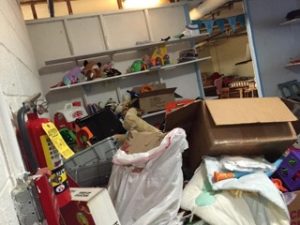 At different times in life, one finds oneself faced with the task of making life-altering changes to pave the way for new possibilities. As an organizer, I have the privilege of being with clients as they journey toward a new life and new possibilities. An inspiring vision is their guiding light and a tool box of new questions is their rudder, navigating them toward their goals and aspirations.
At different times in life, one finds oneself faced with the task of making life-altering changes to pave the way for new possibilities. As an organizer, I have the privilege of being with clients as they journey toward a new life and new possibilities. An inspiring vision is their guiding light and a tool box of new questions is their rudder, navigating them toward their goals and aspirations.
Inspired by speakers Joshua Millbum & Ryan Nicodemus, “The Minimalists”, and Marilee Adams’ book “Change Your Questions, Change Your Life”, I have been exploring the notion that one could change one’s life, its patterns, habits and outcomes simply by changing the questions we ask ourselves. Can it be that simple?
When you think about it, questions illuminate:
Questions shed light on, and offer a deeper understanding of, the choices we make and why. Dr. Adams says, “Our behavior follows our questions” and “new questions shape and direct new behaviors.”
When I began questioning myself about the “stuff” in my life, I noticed there was an innate, underlying meaning I had given to each item that was affecting my decision-making process. During one of my closet purging events, I began to hear the meanings I had assigned each item. Slowing down and listening carefully, I could hear myself arguing for each item and justifying why things should stay, saying:
In other areas of my home and my clients’ homes, I see items being kept for fear that the memory will be lost forever if not saved. Text books, research papers and thesis notes are symbols and trophies of accomplishments and successes representing a former self and held for posterity. Items that have recognized value are held to say something about us even though we don’t like, appreciate or use them.
Why do we give so much meaning to our stuff? Who knows? What I’ve noticed is that when the meaning we give to items remains unexamined and undistinguished, the more likely they are to stay on our shelves versus leave to create space in our lives. Asking rigorous questions and listening intently for the meaning we give to items offer us new interpretations and perspectives, and the freedom to let go.
Questions I like to ask are:
Last week I spoke to someone who was facing a plumbing crisis but needed to declutter large areas before the repair work could be done. Questioning himself, he began to uncover that he was, as he called himself, “Mr. Someday.” Things he acquired and saved were for someday. When he saw something, his question was, “How can I use this, someday?” It’s not such a bad question once in a while, except what he was now facing was all the “someday” projects that never happened and instead were impeding the plumbing repairs. Armed with both a new vision to say goodbye to “Mr. Someday” and new questions to shape his actions moving forward, he was off and running to change his lifestyle and life.
How might life be better if we owned less stuff?
The Minimalists say, “Life can be richer with less stuff.” Dr. Adams’ asks, “What new questions can take us there?”
If letting go to reduce the amount of stuff in your life is your mission and you need help along the way changing your questions to change your life, find an organizer in your area. We would love to support you.
Click on the title above to learn more about the featured author.
 Are you overwhelmed just thinking about organizing your photos? You’re certainly not alone. I have clients, friends and family members who have boxes of old photos and a computer filled with a mishmash of photos. Where to begin? What to keep? Digital vs. physical? Huh???
Are you overwhelmed just thinking about organizing your photos? You’re certainly not alone. I have clients, friends and family members who have boxes of old photos and a computer filled with a mishmash of photos. Where to begin? What to keep? Digital vs. physical? Huh???
Try these ideas for organizing them:
Think of your photos in three categories. Whether physical or digital, you can break down your photos into these categories:
Tip: the ones you want to grab should the house be on fire.
Tip: the ones that trigger good memories or are beautiful.
Tip: they don’t make you smile or look similar to the ones that do.
You’ll need to make some basic decisions. This is the hard part but it needs to be done at the outset of the project.
Decision 1: How do you want to preserve the TREASURES?
Do you want to combine the physical and digital photos into concise collections? Consider these as “coffee table books” that you’ll share with family and friends and peruse periodically on your own.
Here are your options:
Decision 2: How do want to save the KEEPERS?
Do you want to leave the physical Keepers as they are or have them digitized? Do you want to dismantle and cull existing photo albums?
Consider these options:
My recommendations:
Decision 3: How will you carve out time to work on the photo project?
This is a big (and fun!) project that takes time. Analyze your calendar and work style and make a commitment. For example, would two Saturday afternoons a month work for you? In the evenings when you’re watching TV? Make appointments with yourself and mark the times in your calendar.
I truly hope you enjoy the process because to me, photos are the BEST memory triggers. Be very selective in what you keep because the next generation does not want to go through your photos – they just want your TREASURES.
Click on the title above to learn more about the featured author.
 Does your stomach clench just a little bit when you see holiday decorations popping up in stores before Halloween? Is it my imagination or do retailers rush the season just a little bit more each year?
Does your stomach clench just a little bit when you see holiday decorations popping up in stores before Halloween? Is it my imagination or do retailers rush the season just a little bit more each year?
We all react differently to the first signs of the holiday season. Some look forward to gatherings with family and friends, baking cookies and relaxing at home. Others hear a starting gun for a race full of tasks they can only hope to complete in time.
Many things can add to this sense of overwhelm. Seasonal tasks like decorating, writing cards, shopping, baking and hosting – added to a busy work schedule, school activities and volunteer obligations – can cause the need to breathe into a paper bag!
Fear not, my friends. Here are a few things to simplify your holidays.
Shopping without a plan often leads to overspending. Starting early is great, but avoid last-minute sales that entice some to spend even more. Having a list reduces the odds of forgetting co-workers, hostess gifts and, if necessary, a last-minute dash for a new holiday outfit. (In my experience, the less time available to shop, the more I am willing to spend. Desperation = $.) Simply start by creating a plan: total budget = $___, number of people and gifts for each, are you having a party, do you need a new dress?
Take a moment to review the things you treasure most in life. Are they things at all? Toys and sweaters come and go, but experiences become memories. My parents and grandparents were people of modest means but they were creative enough to fool us: house parties with cousins, ice skates with a few homespun lessons, tickets to a show at Radio City and, once, the whole family went to see the Nutcracker! As an adult, it’s still the time spent with the important people in our lives that far outweighs anything bought in a store.
As a recovering perfectionist, realizing the words need to and should only existed in my mind was an epiphany. Therefore, I feel obligated to share this with others. Think of sending cards, baking, hosting parties and so on as a menu. Pick some or all. You don’t need to do everything. (OK, the kids usually appreciate a tree, but the others are optional.) Annual cards can be sent on St. Patrick’s Day if your family celebrates this holiday or on the 4th of July if you celebrate patriotism. If you show your friends and family love throughout the year, there’s no need to make it up at Christmas time, unless it’s your choice.
If you are not familiar with Parkinson’s law, this is a good time of year to learn its original meaning. It’s a simple one: work expands to fill the time available for its completion. Therefore, you can plan a party a la Martha Stewart with place cards, silver service, homemade favors and signature cocktails or, if pressed for time, you can host a potluck dinner. You make the rules.
The most important thing is the reason for the season and the people in your life!
God loves a cheerful giver. (2 Corinthians 9:7)
Click on the title above to learn more about the featured author.
 “Eye of newt, and toe of frog,
wool of bat, and tongue of dog,
adder’s fork, and blind-worm’s sting,
lizard’s leg, and howlet’s wing…” ~William Shakespeare, Macbeth
“Eye of newt, and toe of frog,
wool of bat, and tongue of dog,
adder’s fork, and blind-worm’s sting,
lizard’s leg, and howlet’s wing…” ~William Shakespeare, Macbeth
Reaching into the cupboard for canned pumpkin, you come upon what appears to be a rotting bag of potatoes you’d forgotten that you bought a couple of months ago.
You go down to the basement to pull out your holiday décor and realize it will take days to even get close to the area where it is stored – the boxes you can reach have been chewed into by…something.
You look under a bathroom sink for the ointment you haven’t used since last year’s blister you got while raking and you discover what must be a leaking pipe (and a mass of soggy toiletries).
Just because you have not actively used a storage area for some time, doesn’t mean that it has remained unchanged in your absence. Storage spaces like basements, spare rooms, closets and cabinets can be easily ignored when organizing or cleaning. The items they contain do not present the issue of “visible” clutter. The door is closed and what is stored is not in anyone’s way. Besides, the everyday mass of new paper, gadgets and gizmos coming in that crowd our countertops are enough of a challenge. Who has the time to deal with what’s already stored? Right?
Well, unfortunately, what is out of sight and out of mind is not necessarily out of play in the functioning of our homes and lives.
We want to be able to use the storage that we have in order to be able to put away supplies, seasonal items, sentimental memorabilia and the like, so as to keep them from impinging on our daily living. However, if we continue to shove new items in, we can end up pushing older items back, back, back into the dark recesses known only to the Boogieman. Therefore, an occasional survey of storage spaces can keep them functional and friendly. And, although I doubt you’ll need worry about coming across any ingredients in Shakespeare’s brew, you may want to be prepared for the unexpected when venturing to take-on one of these areas.
If you’ve seen signs of bugs or rodents, consider bringing in an exterminator first and holding off for a week or two on the organizing. If there’s a leak that you cannot find or fix yourself, call a plumber sooner rather than later. Unaddressed leaks and critters can do damage to your health and your home, not to mention your wallet. Take care of them before they turn into a caldron full of trouble.
Let the witches and goblins that ring your bell for candy be your only scary surprise this fall season!
Click on the title above to learn more about the featured author.
 Some of us love change. With each new month we tend to change our clothing, eat different foods and decorate our homes. That’s a lot of work for some of us. How do you remember everything that needs to be done? I use my calendar. Each month reminds me of what needs to be done. Below is a monthly glance at my calendar.
Some of us love change. With each new month we tend to change our clothing, eat different foods and decorate our homes. That’s a lot of work for some of us. How do you remember everything that needs to be done? I use my calendar. Each month reminds me of what needs to be done. Below is a monthly glance at my calendar.
How do you remember?
An easy way to keep up with the changing seasons is to set an event in your calendar for each month and have it notify you. Or, maybe break up things into weekends, starting each Saturday morning with a “things to do list.” I pretty much have it memorized and enjoy the changes that the seasons bring.
Happy autumn to you!
Click on the title above to learn more about the featured author.
 What happens if you love to shop BUT hate to organize? Or you don’t have the time or energy to deal with what you buy?
What happens if you love to shop BUT hate to organize? Or you don’t have the time or energy to deal with what you buy?
All those “great deals” become clutter when you bring things into the home and either don’t have a place to put them right away or haven’t purged things to make room for them. What happens most of the time? The items stay hidden in bags that pile up. Then there’s a problem.
Too much stuff, with no place to put it, leads to clutter and chaos which do not allow the stress-free, organized home you desire.
Before you buy something, ask yourself these questions:
Remember—if a deal seems too good to pass up, but you don’t need the item, you need to put it somewhere if you bring it home. The floor does not count so no bags should be piled up on the floor.
Before buying more things, ask yourself the above questions. You’ll learn over time that the best way to stop clutter is before it enters your home.
Click on the title above to learn more about the featured author.